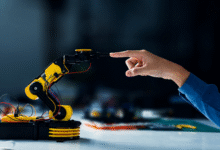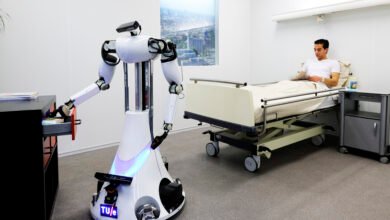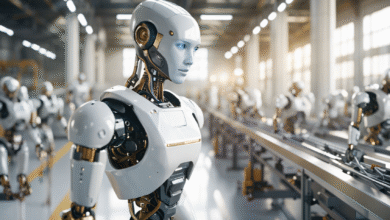
The robotics industry is experiencing unprecedented growth, with the global market projected to reach $80 billion by 2030. As automation continues to revolutionize modern industries from manufacturing and healthcare to aerospace and logistics, the demand for skilled robotics professionals has never been higher. The industrial robotics market is projected to reach $73 billion by 2029, while the U.S. robotics market alone is expected to grow at an impressive compound annual growth rate of 13.5%.
Whether you’re an aspiring robotics engineer, a seasoned professional looking to advance your career, or someone considering a transition into this dynamic field, developing the right robotics skills is crucial for success. The intersection of artificial intelligence, machine learning, and robotics has created exciting opportunities across multiple sectors, from industrial automation to space exploration.
Today’s robotics professionals need a diverse skill set that combines technical expertise with problem-solving abilities and collaborative skills. According to Fortune Business Insights, the global robotic process automation market is expected to reach $50.5 billion by 2030, a dramatic increase from its 2022 valuation of $10 billion. This explosive growth translates to thousands of high-paying job opportunities for those equipped with the essential skills.
The robotics career landscape is particularly attractive, with Glassdoor’s median average salary for a Robotics Engineer currently at $95,801, and many entry-level positions starting at $60,000 annually. What makes this field even more appealing is that many robotics jobs don’t require traditional four-year degrees, focusing instead on practical skills and hands-on experience.
In this comprehensive guide, we’ll explore the ten most critical robotics skills that professionals need to excel in modern industries. From programming languages and artificial intelligence to mechanical design and soft skills, we’ll provide detailed insights into each competency area. You’ll discover not only what skills are essential but also how to develop them effectively, where they’re most valuable, and why they’re crucial for your robotics career success.
1. Advanced Programming Skills and Software Development
Programming skills form the backbone of modern robotics, serving as the primary interface between human intent and robotic execution. Advanced programming skills remain a cornerstone for Robotics Engineers entering 2024, with proficiency in programming languages such as Python, C++, and ROS (Robot Operating System) being crucial for developing the software that controls robotic systems.
Essential Programming Languages for Robotics
Python has emerged as the dominant programming language in robotics due to its versatility and extensive libraries for machine learning and artificial intelligence. Its simple syntax makes it ideal for rapid prototyping, while powerful frameworks like TensorFlow and PyTorch enable sophisticated AI implementations. Python’s integration with ROS (Robot Operating System) makes it indispensable for robotics development.
C++ remains critical for low-level system programming and real-time applications where performance is paramount. Many robotic control systems, especially in industrial automation, rely on C++ for its speed and efficiency. Understanding C++ is essential when working with embedded systems and hardware interfaces.
Robot Operating System (ROS) isn’t technically a programming language but rather a middleware framework that’s become the industry standard. Developers skilled in Python, ROS (Robot Operating System), and C++ are in high demand across the robotics sector.
Software Architecture and System Design
Modern robotics applications require sophisticated software architecture that can handle multiple concurrent processes, sensor integration, and real-time decision making. Understanding design patterns, modularity, and scalable system architecture is crucial for developing robust robotic systems that can operate reliably in complex environments.
Version Control and Collaborative Development
Version control systems like Git are essential for robotics projects that involve multiple team members and continuous iteration. Understanding collaborative development workflows, code review processes, and project management tools helps robotics professionals work effectively in team environments.
2. Artificial Intelligence and Machine Learning Expertise
Artificial Intelligence and machine learning have transformed robotics from simple programmed machines to intelligent systems capable of learning and adapting. Machine learning and artificial intelligence (AI) proficiency is becoming increasingly essential for Robotics Engineers, as the integration of AI into robotics continues to advance, enabling robots to perform tasks with greater autonomy and adaptability.
Core AI Concepts in Robotics
Understanding neural networks, deep learning architectures, and reinforcement learning is fundamental for developing intelligent robotic systems. These technologies enable robots to recognize patterns, make decisions, and improve their performance over time through experience.
Computer vision algorithms allow robots to interpret and understand visual information from their environment. This includes object recognition, facial recognition, depth perception, and scene understanding – all critical for autonomous navigation and manipulation tasks.
Machine Learning Applications
Supervised learning techniques help robots learn from labeled datasets, while unsupervised learning enables pattern discovery in unlabeled data. Reinforcement learning is particularly valuable for robotics as it allows systems to learn optimal behaviors through trial and error, much like human learning.
Natural Language Processing
As robots become more interactive with humans, natural language processing (NLP) skills become increasingly valuable. This enables robots to understand and respond to voice commands, engage in conversations, and provide meaningful feedback to users.
3. Mechanical Engineering and Design Principles
Mechanical engineering knowledge is fundamental to robotics, encompassing the physical design, movement mechanisms, and structural integrity of robotic systems. Understanding how to design and integrate hardware components like sensors, motors, and circuits is essential for creating functional and efficient robots.
Mechanical Design and CAD Proficiency
Computer-Aided Design (CAD) software proficiency is crucial for robotics professionals. Tools like SolidWorks, AutoCAD, and Fusion 360 enable engineers to create detailed mechanical designs, simulate physical properties, and optimize component interactions. Experience with CAD software (like SolidWorks or AutoCAD) is a big plus for robotics career advancement.
Kinematics and Dynamics
Understanding kinematics (the study of motion without considering forces) and dynamics (the study of forces and their effects on motion) is essential for designing robotic arms, mobile robots, and complex multi-joint systems. This knowledge enables engineers to predict and control robotic movement with precision.
Materials Science and Manufacturing
Knowledge of materials properties, manufacturing processes, and production techniques helps robotics engineers select appropriate materials and design components that are both functional and cost-effective. Understanding 3D printing, CNC machining, and traditional manufacturing methods expands design possibilities.
Actuators and Mechanical Systems
Expertise in servo motors, stepper motors, pneumatic systems, and hydraulic actuators is crucial for implementing robotic movement. Understanding the trade-offs between different actuation methods helps engineers select the best solutions for specific applications.
4. Electrical and Electronic Systems Knowledge
Electrical engineering expertise is indispensable in robotics, as it enables the integration of sensors, actuators, and control systems that bring mechanical designs to life. Control System Engineers who design the electronic systems that control robotic machinery play a crucial role in ensuring robots operate efficiently and safely.
Circuit Design and Analysis
Understanding circuit design principles, including analog and digital circuits, power management, and signal processing, is fundamental for robotics applications. Engineers must be able to design custom circuits for sensor integration, motor control, and communication systems.
Embedded Systems Programming
Embedded systems form the computational core of most robotic systems. Proficiency in microcontroller programming, real-time operating systems, and hardware-software integration is essential for creating responsive and reliable robotic systems.
Sensor Integration and Signal Processing
Modern robots rely on numerous sensors for environmental awareness and feedback control. Understanding sensor technologies including cameras, LIDAR, ultrasonic sensors, accelerometers, and gyroscopes, along with signal processing techniques, is crucial for effective sensor integration.
Power Systems and Energy Management
Designing efficient power systems and implementing effective energy management strategies is critical for mobile robots and autonomous systems. This includes battery selection, power regulation, and energy optimization techniques that maximize operational time and system reliability.
5. Systems Thinking and Integration Capabilities
Systems thinking is a crucial skill that enables robotics professionals to understand complex interactions within robotic systems and troubleshoot multifaceted problems. Systems thinking involves understanding the complex interactions within robotic systems and the ability to troubleshoot multifaceted problems, requiring Robotics Engineers to break down large-scale systems into manageable components.
Holistic System Design
Effective robotics professionals must understand how mechanical, electrical, and software components interact to create functional systems. This includes managing system complexity, optimizing component interactions, and ensuring overall system reliability and performance.
Integration Methodologies
System integration requires knowledge of various communication protocols, interface standards, and integration patterns. Understanding how to connect different subsystems, manage data flow, and maintain system coherence is essential for complex robotics projects.
Testing and Validation
Systematic testing methodologies and validation procedures ensure that integrated systems meet performance requirements and safety standards. This includes unit testing, integration testing, and system-level validation procedures.
Documentation and Standards
Maintaining comprehensive documentation and adherence to industry standards is crucial for system integration success. Understanding documentation best practices and relevant industry standards helps ensure system maintainability and regulatory compliance.
6. Problem-Solving and Analytical Thinking
Problem-solving abilities are perhaps the most universally important skills in robotics, as professionals regularly encounter complex technical challenges that require creative and analytical solutions. Designing and building functioning technical systems is critical, but it’s just as important to be able to figure out why a system isn’t functioning properly.
Debugging and Troubleshooting
Debugging skills are essential for identifying and resolving issues in both hardware and software components. This includes systematic approaches to fault diagnosis, root cause analysis, and iterative problem resolution. If it’s a mechanical issue, you’ll need to know the best practices for making a repair. If it’s a software issue, you’ll need to be ready to look for errors or bugs in the code.
Critical Thinking and Analysis
Analytical thinking enables robotics professionals to evaluate complex problems, assess multiple solution approaches, and make informed decisions based on available data and constraints. This skill is crucial for optimizing system performance and making design trade-offs.
Creative Problem-Solving
Innovation in robotics often requires thinking outside conventional boundaries. Creative problem-solving skills help engineers develop novel solutions, adapt existing technologies for new applications, and overcome seemingly impossible technical challenges.
Systematic Methodology
Employing systematic problem-solving methodologies ensures consistent and effective issue resolution. This includes structured approaches to problem identification, solution generation, evaluation, and implementation.
7. Data Analysis and Computational Skills
In the era of intelligent robotics, data analysis skills have become increasingly important for understanding system performance, optimizing algorithms, and implementing machine learning solutions. As robots become more intelligent, professionals who can work with AI, machine learning, and big data are essential to develop smarter and more adaptable systems.
Statistical Analysis and Data Interpretation
Understanding statistical methods and data interpretation techniques is crucial for analyzing sensor data, evaluating system performance, and making data-driven decisions about system improvements and optimizations.
Big Data and Cloud Computing
Modern robotic systems generate vast amounts of data that require efficient processing and storage solutions. Knowledge of big data technologies, cloud computing platforms, and distributed processing systems is increasingly valuable for robotics applications.
Simulation and Modeling
Simulation tools and computational modeling are essential for testing robotic systems before physical implementation. Proficiency in simulation software and mathematical modeling techniques enables engineers to optimize designs and predict system behavior.
Algorithm Development and Optimization
Creating efficient algorithms for path planning, control systems, and decision-making requires strong computational thinking skills. Understanding algorithmic complexity, optimization techniques, and performance analysis is crucial for developing high-performance robotic systems.
8. Communication and Collaborative Skills
While robotics is highly technical, success in the field requires strong communication skills and the ability to work effectively in multidisciplinary teams. Being a team player is essential, as you can expect to be working with five or six other engineers, a project manager, product developers, and a user experience expert.
Technical Communication
Technical writing and presentation skills are crucial for documenting designs, communicating with stakeholders, and collaborating with team members. The ability to explain complex technical concepts to non-technical audiences is particularly valuable.
Cross-Disciplinary Collaboration
Robotics projects typically involve professionals from multiple disciplines including mechanical engineering, electrical engineering, computer science, and often domain-specific expertise. Effective collaboration requires understanding different perspectives and communication styles.
Project Management
Understanding project management methodologies and tools helps robotics professionals contribute effectively to project planning, execution, and delivery. This includes knowledge of agile methodologies, timeline management, and resource allocation.
Leadership and Mentoring
As robotics professionals advance in their careers, leadership skills become increasingly important. The ability to mentor junior team members, lead technical initiatives, and guide strategic decisions contributes significantly to career advancement.
9. Industry-Specific Domain Knowledge
Domain expertise in specific industries where robotics applications are deployed provides significant competitive advantages and opens specialized career opportunities. Understanding industry-specific requirements, regulations, and best practices is crucial for developing effective robotic solutions.
Manufacturing and Industrial Automation
Industrial automation knowledge includes understanding manufacturing processes, production line optimization, quality control systems, and safety regulations. Manufacturing, healthcare, transportation, supply chain, surveillance, construction, and even food industries rely on robotics to develop fast and meaningful solutions.
Healthcare and Medical Robotics
Medical robotics requires an understanding of medical procedures, regulatory requirements, biocompatibility standards, and patient safety protocols. This specialized knowledge is essential for developing surgical robots, rehabilitation devices, and diagnostic systems.
Aerospace and Defense Applications
Aerospace robotics involves unique challenges, including space environment considerations, extreme reliability requirements, and specialized communication systems. Understanding aerospace standards and requirements opens opportunities in space exploration and defense applications.
Agricultural and Environmental Robotics
Agricultural robotics requires knowledge of farming practices, crop management, environmental monitoring, and sustainable agriculture principles. This growing field offers opportunities to address global food security challenges.
10. Continuous Learning and Adaptability
The robotics field evolves rapidly, making continuous learning and adaptability essential skills for long-term success. Robotics Engineers must not only have a firm grasp of foundational skills but also be agile learners, ready to adapt to new technologies and methodologies.
Technology Trend Awareness
Staying current with emerging technologies, research developments, and industry trends is crucial for maintaining relevance in the robotics field. This includes following academic research, industry publications, and technology conferences.
Professional Development
Engaging in professional development activities including certifications, workshops, conferences, and advanced education helps robotics professionals stay current and advance their careers. Specializing in core areas like programming, coding, embedded system design can help you acquire the desired skill sets and give you an edge over other professionals.
Experimental Mindset
Maintaining curiosity and willingness to experiment with new technologies, approaches, and solutions is essential for innovation in robotics. A little bit of creativity can go a long way for a robotics professional, beneficial for solving problems, such as using an existing part in a new way or coming up with a brand-new design altogether.
Network Building and Community Engagement
Building professional networks through industry associations, conferences, and online communities provides access to learning opportunities, career advancement, and collaborative projects. Through internships and conferences, you can meet key contacts who can offer career advice, provide advanced robotics training, and ultimately open up opportunities for successful careers in robotics.
Conclusion
The robotics industry offers unprecedented opportunities for professionals equipped with the right combination of technical skills, analytical thinking, and collaborative abilities. As automation continues to transform modern industries, the demand for skilled robotics professionals will only continue to grow. The ten essential robotics skills outlined in this guide – from programming and artificial intelligence to systems thinking and continuous learning – provide a comprehensive foundation for success in this dynamic field. Whether you’re starting your robotics journey or looking to advance your existing career, developing these competencies will position you for success in the exciting world of robotics engineering. The key to thriving in robotics lies not just in mastering individual skills, but in understanding how they integrate to create intelligent, efficient, and innovative robotic solutions that address real-world challenges across industries.











